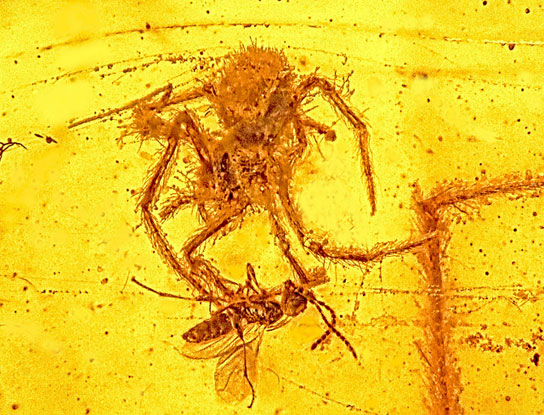
A Cretaceous period juvenile spider was trapped in amber before it could devour a male wasp caught in its web. This is the first time that such a scene has been found in the fossil record.
The scientists published their findings in the journal Historical Biology. This event occurred in the Early Cretaceous period, about 97 to 110 million years ago, in the Hukawng Valley, in Myanmar. Undoubtedly, dinosaurs were around this area as well. The spider is a social orb-weaver spider (Geratonephila burmanica) and the wasp is of the species Cascoscelio incassus, both of which are extinct today.
Wasp species are known to parasitize spider eggs. This wasp was watching the spider just as it was about to be attacked. That’s when the tree resin flowed over and captured them both, states entomologist George Poinar Jr. of Oregon State University.
Another spider was captured some distance away, also in amber, and could have been co-habiting the same web as the juvenile. Males of modern-day social orb-weavers are typically found living on female-constructed webs, where they usually assist in capturing insects and maintaining the web.
There are also droplets on the fossil web that contain aerial plankton, which basically are pollen, spores, and dust particles from that time.
Reference: “Predatory behaviour of the social orb-weaver spider, Geratonephila burmanica n. gen., n. sp. (Araneae: Nephilidae) with its wasp prey, Cascoscelio incassus n. gen., n. sp. (Hymenoptera: Platygastridae) in Early Cretaceous Burmese amber” by George Poinar Jr. and Ron Buckley, 2 December 2011, Historical Biology.
DOI: 10.1080/08912963.2011.640399
2 Comments
Notice the lack of evolutionary evidence.. already exactly like they were created.. Hmm .. real scientists look at everything.. Darwidiots look only at false longings..
“both of which are extinct today.”
I hope you read your Bible better than you did the article your criticising.
Could explain a lot.